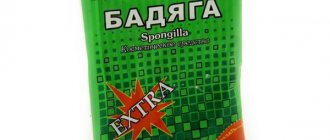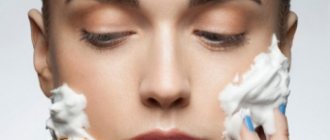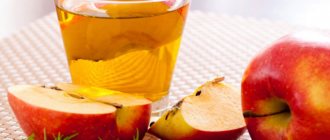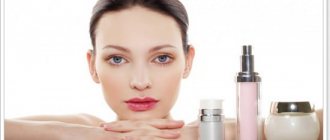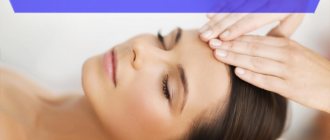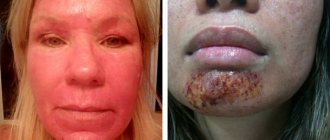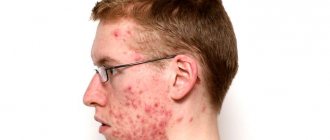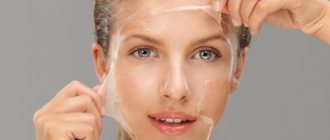Glycolic peeling is a procedure whose demand is confirmed by positive reviews from patients and specialists. Popularity is associated with the effectiveness of the method for solving not one, but a number of problems. It is well known that the “stronger” the remedy, the more carefully you need to handle it, understand the nuances, and adhere to the authoritative opinion of experts.
Glycolic peeling
Peeling at its core is the exfoliation of dead skin cells of the epidermis - the surface layer of the skin. Glycolic peeling is a type of chemical peeling and is achieved by the action of fruit acids on skin cells. Unlike the natural processes of skin renewal, it is much more active and, according to some experts, more aggressive.
The glycolic version of the peel is considered quite aggressive
What is useful to know about glycolic peeling? How not to make a mistake in the “pros and cons” question? How to avoid side effects during its implementation? Is it worth practicing it at home? The answers to these questions will help you make the right choice.
From the history
The first mentions of glycolic peeling were found in historical facts about Ancient Egypt. We are talking about using sugarcane juice for rejuvenation. Indeed, this acid is found in the juice of many fruits: sugar beets, green grapes, pineapples.
Interesting ! The method emerged as a cosmetic procedure in the second half of the 20th century. This is due to advances in the study of the properties of glycolic acid. In addition to peeling itself, it promotes collagen synthesis and solves the problems of “aging” skin.
The technique originated in the second half of the 20th century
The introduction of the method into practice was preceded by clinical experiments. One of these took place in 1996. An experimental group of 41 people was created, which included patients of different ages and initial skin conditions.
Once a week, a 50% solution of glycolic acid was applied to the skin. The experiment was carried out over 4 weeks. After carefully studying the results, scientists came to the following conclusions: the layer of “dead” cells decreased, the layer of functioning epidermal cells increased, and the photosensitivity of the skin decreased. Particularly interesting were the results in the form of rejuvenation and the disappearance of fine wrinkles.
Important ! Changes occurred in 90% of study participants.
Documentary confirmation of this fact contributed to the introduction of the procedure into cosmetology practice.
The experiment has proven the effectiveness of such a remedy
What is a glycolic peel?
Peels using fruit acids have been around for a long time and are time-tested. Popular categories include milk, almond, lemon. They contribute to the renewal of the surface layer of the epidermis - the stratum corneum. Glycolic peeling has the properties of all the previous ones and also has a rejuvenating effect on the deeper layers, thanks to the high penetrating ability of the active substance.
Important ! This provides the effect of evening out skin color and getting rid of fine wrinkles.
Fruit acids have an effective effect on the skin
Mechanical facial peeling
Let's compare it with soft sanding of the leather surface using a natural brush or abrasive substances. You may be offered peeling with coral chips, aluminum particles, and dry herbs. Best suited for young skin. Remember that the best time for peeling is the autumn-winter months, when solar activity is low, otherwise, under the influence of ultraviolet radiation, pigment spots will remain on unprotected skin. In conclusion, I would like to wish you to make the right choice and preserve your beauty and youth for many years.
Properties of glycolic acid and benefits for the skin
The source of glycolic acid is natural products. By chemical nature it is an acid. Like any active substance capable of entering into chemical reactions, its effect depends significantly on concentration.
Concentration affects the result
Let's consider the main properties of hydroxyacetic acid that contribute to beneficial effects on the skin.
- Glycolic acid has a small molecular weight and has the ability to penetrate deep into the skin, where it effectively breaks down keratinization, entering into chemical reactions and disrupting the connections between dead cells.
- The active substance promotes the production of collagen and fibroblasts. Externally, this effect manifests itself as a rejuvenating effect: skin elasticity increases, facial tone is evened out.
- The exfoliant provides a lifting effect due to its effect on connective tissue cells: deep wrinkles are smoothed out and become less noticeable, fine wrinkles disappear, and the overall relief is evened out.
- Peeling helps to “cleanse” the skin. Thanks to the anti-inflammatory effect, the procedure has a therapeutic effect on acne and helps to reduce the inflammatory process.
- Along with other effects, a hydrating effect is manifested, which is possible due to the ability of the exfoliant to be saturated with water molecules. Experts and patients note the softness and optimal hydration of the skin.
Glycolic peel moisturizes skin - The manifestation of acid properties has a regulating effect on the acid-base balance in tissues. This stimulates microcirculation, optimizes secretion production by the sebaceous glands and has a noticeable effect on the overall condition of the skin.
- Hydroxyacetic acid eliminates the effect of excessive pigmentation.
- One of the properties of this substance is to smooth out minor scars and scars.
- The product has a complex effect, reveals itself on many levels: improves elasticity, refreshes the skin, evens out its texture, moisturizes, and cures acne. The effect of this procedure appears on the skin of people of all age categories.
- If the indications are followed and there are no contraindications, glycolic peeling acts carefully, within the boundaries of the problem area and the assigned tasks.
This peeling is gentle on the skin.
Peeling, like any cosmetic procedure, can lead to undesirable results. It is not enough to read the indications and the procedure to repeat it yourself. Glycolic peeling, especially when using a high concentration of the drug, is safe if performed professionally.
Important ! Despite the fact that the method is relevant for almost any skin type and at different ages, an individual approach always comes to the fore. An experienced specialist will conduct a session taking into account the characteristics of the skin, age, and somatic diseases.
An individual approach to the procedure is required
Mechanism of action of fruit chemical peeling
An important property of the skin is its ability to regenerate. Thanks to this property, various cosmetic procedures are possible. The stratum corneum of the skin is not a frozen structure, but a mobile system in constant motion. Old, dead scales are regularly exfoliated, and their place is taken by new cells from the deep layers of the epidermis.
This process is called keratinization (keratin synthesis) because during the exfoliation process, new cells are filled with keratin, a strong, elastic protein. When carrying out peeling (exfoliation), we achieve the process of keratinization.
Glycolic acid is an alpha hydroxy acid (naturally occurring fruit acid). It is found in oranges, pineapples, grapes, sugar cane, and sugar beets. It is obtained mainly from sugar cane. Due to its low molecular weight, glycolic acid easily passes through the transepidermal barrier, penetrating into the deeper layers of the skin. Consequently, procedures based on it are distinguished by the most effective exfoliating, stimulating and antioxidant effects.
What exactly happens during a glycolic peel? Glycolic acid causes a number of chemical reactions when applied to the skin.
The spectrum of effects of glycolic acid on the skin is very wide due to the effective combinations of ingredients in peeling products. This allows us to work on a particular problem, taking into account the individual characteristics of the patient as much as possible. When glycolic acid is applied to the skin, chemical reactions occur that release keratinocytes. Old dead cells are eliminated and new ones appear. After some time after the rehabilitation period, the skin becomes young, light and soft.
Neutralization and destruction of intercellular contacts (protein connections) occurs, with the help of which keratinized skin cells (corneocytes - flat scales) are fixed to each other. This causes the stratum corneum to peel off and replace corneocytes with keratinocytes. Glycolic peeling helps to enhance the synthesis of keratin and accelerate the exfoliation of the stratum corneum, smoothing the skin texture, normalizing pigmentation, which leads to an improvement in the appearance of the skin and its condition.
Types of glycolic peeling
Due to different tasks, there are two types of glycolic peeling.
- Superficial exfoliation is carried out using acid with a concentration of up to 40%. The pH level ranges from 2.4 to 4.5. The main effect of this procedure is the removal of dead cells from the surface of the epidermis. Experts recommend it to young patients to even out the relief and tone of the face, and regulate the secretions of the sebaceous glands. The expected result is fresh skin in a fairly short period of time. For example, the need to look presentable before an important event.
Superficial exfoliation - Aggressive peeling provides a deeper effect on the skin. This is understandable, because the concentration of the active substance increases. The content of hydroxyacetic acid reaches 70%, and the hydrogen index is at least 2.8 (the lower the index, the more pronounced the properties of the substance as an acid). The depth of impact of such peeling is assessed as superficial-medium or intermediate. The drug penetrates the dermis and causes a more active response: pronounced redness of the skin, peeling, and the formation of a brown crust. The pain of the procedure increases due to these features. When reading the symptoms described above, it is worth remembering that this is the price of a more pronounced result. This procedure is more suitable for patients over 30 years of age.
Aggressive exfoliation
Specifics of fruit peeling
Glycolic peeling is a type of fruit peeling based on alpha hydroxy acids. Among modern methods used in cosmetology, it occupies a leading position. The mechanism of action of glycolic peeling is well researched and can be clearly predicted, which makes it very popular among cosmetologists and patients of cosmetology clinics. With a minimum of contraindications and side effects, this is a very effective and gentle cosmetic procedure.
With the help of glycolic peeling, you can qualitatively slow down the natural aging process of the skin, eliminate some of its defects, improve complexion, even out skin texture, remove age spots and post-acne scars. It is also attractive because it can be performed not only in cosmetology clinics, but also at home.
Chemical fruit peels are usually carried out in two versions:
- surface;
- aggressive.
Superficial peeling acts only on the stratum corneum of the skin, removes dead cells, evens out skin color, and improves skin texture. This option is performed on young skin with some minor problems (minor acne).
The big advantage of this option is its frequent use or emergency use in the event of some special event.
Aggressive peeling has a deeper penetration of glycolic acid into the skin. It activates the division of dermal fibroblasts and keratinocytes of the stratum corneum. The skin after the procedure looks very hyperemic, painful on palpation, with the formation of a brown crust. But after some time it regenerates and takes on a healthy and youthful appearance.
It is now believed that peeling with fruit acids is an innovation in the field of cosmetology. But in fact, the fruit acid peeling method has been used for a very long time, for thousands of years.
Before undergoing chemical exfoliation, you should make an appointment with a cosmetologist two weeks before the intended procedure. This is necessary in order to carry out doping activities. Of course, this is not always a mandatory measure, but preparing for peeling will help reduce unwanted consequences that may arise during the procedure.
It is recommended to carry out peeling in courses, usually 5-10 sessions, during which it is possible to increase the concentration of the active substance. Sometimes the result can be observed after the first procedure, but it all depends on the condition of the skin and the goals being pursued. For some, 1-2 sessions are enough, while others need more procedures.
At the very beginning of the procedure, the cosmetologist applies a weak solution of glycolic acid to the facial skin to soften and degrease the skin. Then the glycolic gel itself is applied evenly, strictly in the direction from the forehead to the chin, which remains on the skin for only a few minutes. The next step is to remove the main active gel with a special neutralizing solution, in the same strict sequence - from the forehead to the chin.
The cosmetologist must carefully monitor the skin, and if particularly hyperemic and swollen spots appear during the procedure, then they urgently need to be neutralized. If there are more than three foci of inflammation, then immediately remove all the gel from the face, and the neutralizer solution is washed off with plenty of water. Be sure to apply a moisturizing, soothing and anti-inflammatory mask in combination. Such manifestations are extremely rare and are associated with personal intolerance to the main gel.
If no excesses are observed during the procedure, then the session itself takes a small amount of time and is attractive in that it does not cause the slightest discomfort during its implementation. Sometimes a slight burning sensation may occur, but these are mild sensations that are not very painful, and they are easily eliminated by a stream of cool air. Unlike other types of peeling, glycolic peeling is extremely comfortable and pleasant.
Indications
Exfoliation with glycolic acid is indicated if:
- even out the relief of facial skin, get rid of residual effects of inflammatory processes;
- prevention of premature aging;
- treat comedones and acne;
- restore or increase skin elasticity, achieve a lifting effect due to the disappearance of facial wrinkles;
You can achieve skin elasticity - moisturize the skin, improve its elasticity;
- support the skin after excessive sun exposure;
- correction for thickening of the stratum corneum of the epidermis;
- get rid of age spots (with the exception of cases of systemic diseases);
Peeling gets rid of age spots - regulate the secretion of the sebaceous glands during seborrhea;
- eliminate the effect of enlarged pores;
- treat viral dermatosis caused by molluscum contagiosum;
- eliminate defects in the form of shallow stretch marks;
- prepare for face resurfacing or plastic surgery.
Glycolic peeling can be used before other procedures
Algorithm for carrying out in the salon (3 steps)
Indications for glycolic exfoliation cover patients with almost any type of skin and different age groups. In addition, there is a selective depth of action of the active substance, which allows you to regulate the effects and their intensity.
There are different peeling tactics based on the use of exfoliants with different concentrations. For example, the first two sessions are carried out with a low content of glycolic acid, within 20%. Further, in increasing order, from 35% to 50% of the solution until the final effect in the form of final peeling.
The acid concentration increases gradually
So, the process is safely controlled by the choice of concentration and application layers. It is important that all the nuances are able to be clarified, taken into account and developed by a medical specialist with experience in this field. Therefore, the best option is to go to the clinic and trust the professionals.
It is worth noting! An important argument in favor of a salon procedure is that the skin must be properly prepared.
It's better to trust the professionals
Over a two-week period, the skin is treated with a low-concentrated solution of hydroxyacetic acid to break the bonds between the obsolete cells of the surface layer of the epidermis. Due to its low molecular weight, the drug gradually penetrates into the deeper layers of the skin, increasing their sensitivity.
Pre-peeling preparation can be carried out at home, using cleansers, lotions and creams selected on the advice of a doctor.
Then it’s time for the actual salon procedure.
Preparation for the procedure is required
There are three stages in its implementation.
- Immediately before peeling, the skin is treated with a special cleansing and degreasing agent.
- An even layer of glycolic acid of the selected concentration is applied. The exposure is maintained. The patient is warned that he will feel skin tingling, itching or tingling.
- A solution is applied - a neutralizer, which stops the action of the acid. At the end of the procedure, the skin is moisturized with cream.
The procedure is carried out in three stages
To reduce the unpleasant burning sensation during exfoliant exposure, use a special device that blows on the skin. This reduces pain without interfering with the effect of the procedure.
Important ! The time of exposure and the specifics of the session are all controlled by a specialist.
Features of care after the procedure
It was previously said that the effects of peeling can be strong and cause a number of responses in the body. In fact, the effect of acid has been compared to a burn. Therefore, before the procedure, the doctor prepares not only the skin, but also the patient himself - he tells in detail what rules must be followed, how the rehabilitation period proceeds.
One of the frequent questions that patients ask is how quickly the pain and burning go away. Usually, the discomfort goes away with the end of the session. In case of hypersensitivity, it may persist in a mild form the next day.
Unpleasant sensations usually go away with the end of the session
Potential reactions also include swelling and redness of the treated area. Their intensity depends on the characteristics of the skin and the depth of peeling. But most often the period of maximum manifestation is several hours after manipulation.
Sometimes brown crusts form. They should never be removed, as additional trauma may lead to scarring or areas of hyperpigmentation.
Peeling is an expected skin reaction after peeling. To reduce discomfort, you can use moisturizing creams recommended by your doctor.
Your skin may peel, and that's normal.
Therapeutic effects, the time of their manifestation, the boundaries of normal sensations are discussed with the doctor. If an unexpected reaction occurs, you should contact a specialist.
The course consists of sessions, the number of which is determined by the doctor. Usually from 4 to 10 manipulations are performed. The amount may vary depending on the initial condition of the skin, age, and problems being solved.
The doctor, considering each individual case, determines the required number of procedures
Skin care continues between sessions. Usually it involves treatment with weak solutions of hydroxyacetic acid to consolidate the result.
It is best to plan glycolic peeling in the autumn-winter season, so as not to expose the skin to the aggressive effects of ultraviolet radiation. And even when the sun is not too active, it is worth using sunscreen with an SPF effect of at least 30.
It is better to carry out the procedure in autumn or winter
Important ! During the course, you should avoid active water procedures, visiting the sauna, bathhouse, and swimming pool.
Skin care during the post-peeling period
It is very important to follow some rules of skin care during the post-peeling period.
- Avoid sunbathing or simply being in direct sunlight. They can worsen the condition of the skin and negate the effect of the procedure.
- you should refrain from visiting baths and saunas during the period of skin regeneration
- Do not apply decorative makeup to your skin for two weeks
- do not forget to use protective and restorative post-peeling masks and creams
- see a cosmetologist and inform him about the slightest problems that arise
Compliance with these rules and measures will help the skin recover in a short period.
How to carry out the procedure at home?
It is possible to remove dead cells and improve skin condition at home.
Cosmetics manufacturers produce ready-made formulations of safe concentrations for carrying out the session yourself. An important condition for the effectiveness of salon and home procedures is the preparation of the facial skin. For this purpose, cosmetics containing fruit acid (usually a small concentration) are applied for 1-2 weeks. The drug is applied once before bedtime.
Preparation before the procedure is important
Let's consider the procedure for carrying out the manipulation.
- The composition is applied to clean skin. The face is rinsed with water and gently, without rubbing, dried with a clean towel.
- The peeling preparation is applied using a fan-shaped cosmetic brush. The instructions describe the amount of the drug to be applied (one layer) and application patterns. The sequence should be followed: chin, nose, forehead, cheeks. It is important to avoid getting the peeling agent on the area around the eyes. Movements should be neat, smooth, without pressure.
- An important point is the exposure of the drug. The recommended time ranges from 2 to 15 minutes. It depends on the individual characteristics of the skin, age, and characteristics of the peeling product (primarily concentration).
- After the designated time, the facial skin is treated with a neutralizer. A solution of baking soda will do this role perfectly: a teaspoon of the substance per glass of water. Soak a cotton swab with the prepared mixture and carefully remove the exfoliant from the treated area.
- Residues are washed off with water. Usually the procedure ends with the application of a moisturizer or action mask. For this purpose, you can use a product containing jojoba oil.
The full course includes 4-6 procedures. For safety reasons, a gap of 1-2 weeks must be maintained between sessions.
It is necessary to take breaks between courses of therapy
It is worth noting ! It is important to be attentive and careful when carrying out the procedure yourself. At the first sign of a problem, you must end the session.
To properly navigate the situation, let’s look at the list of possible complications.
Unpleasant consequences after peeling
Glycolic peeling can have side effects and complications associated with various reasons.
- High acid concentration and increased exposure time can cause first or even second degree burns. At the first signs of deviation of the procedure from the normal course, you should neutralize the effect of the acid and contact a specialist. It is also worth getting advice about the next sessions. They are carried out after the completion of the rehabilitation period.
- Hyperpigmentation in the post-peeling period may occur due to increased skin sensitivity. Therefore, the specialist must warn you about the need to follow the following rules: use sunscreen, carry out the procedure in the autumn-winter period. By following the recommendations, you can avoid the appearance of age spots on your facial skin.
- Allergic reactions can be minimal or significant - from itching, rash to systemic reactions. The best way to prevent such complications is to conduct a test. A detailed description is available in the instructions for the drug.
Allergies may occur as a result of exposure to fruit acids - It is worth remembering that severe swelling on the face can lead to difficulty breathing. In such cases, call emergency services immediately.
- If the allergic reaction is not life-threatening, you should neutralize the acid and consult a doctor.
- Peeling is accompanied by a feeling of dryness and tightness of the skin. The specialist will prescribe a suitable moisturizer.
Glycolic peeling at home is possible and safe if you follow the rules, recommendations of specialists, and instructions for the drug. The best protection against complications is their prevention.
It is worth considering the possible consequences in advance
Is it possible to do this and does it help in treatment?
With the help of peeling, cells whose life cycle has completed are removed from the surface of the skin.
Peeling:
- evens out the terrain;
- reduces pores;
- removes acne marks;
- gives the skin a healthy glow.
We recommend: What is a peeling mitten, how to make it yourself? Top 5 best ready-made products
also help reduce the oiliness of your facial skin, which slows down the formation of new acne. A disease such as acne cannot be cured with the help of cosmetic procedures alone.
We need a comprehensive approach to the problem, which will include examination of the gastrointestinal tract, endocrine and genitourinary systems. You may need to reconsider your diet and reduce the amount of stress in your life. But during and after treatment, to maintain the beauty of the skin, you can and should do peeling. It is important to choose a suitable procedure together with a cosmetologist, which you can then carry out independently at home.
Contraindications
Before agreeing to the procedure, it is worth studying the contraindications in detail:
- signs of inflammation and damage to the integrity of the skin in the peeling area;
- allergy to exfoliation preparations or their components;
- symptoms of exacerbation of herpetic infection or its consequences;
- benign and malignant skin tumors;
- rosacea;
- use of products containing vitamin A analogues;
Products containing vitamin A analogues are not allowed during the course of procedures. - pregnancy, lactation period;
- pigmentation disorders due to systemic diseases;
- increased skin sensitivity to ultraviolet radiation;
- condition after chemotherapy;
- fresh tan;
- spring-summer season;
- age less than 15 years.
Contraindications should be taken into account
If you want to combine several cosmetic procedures, you must inform your doctor about your plans. Some of them may not be compatible.
Contraindications for carrying out
Even such a harmless procedure as glycolic peeling has its contraindications. You should not peel:
- during pregnancy and lactation
- in warm and hot seasons (spring and summer)
- if there are warts and tumors on the face
- during an exacerbation of herpes disease
- for rosacea
- if the patient has an allergic disease
- in case of inflammatory processes on the face of bacteriological and viral etiology
- in case of wounds and damage to the facial skin (scratches, abrasions) There are also age-related contraindications. Typically, this procedure is not performed on patients under 15 years of age; for other ages, it is quite favorable.
Cost of drugs
Among the companies producing glycolic peeling products, we can note products from Belita-Vitex (50% concentration with an pH value of 2.5), as well as from Medical Collagene 3D Easy Peel (10% concentration with a pH value of 2.8 ). The products are available for purchase in cosmetic stores, pharmacies or online stores.
Products produced in Russia can be purchased at prices ranging from 500 to 2,500 rubles, depending on the number of milliliters. Belarusian manufacturers offer their drugs at a price of 1,000 – 1,500 rubles per 250 ml bottle.
Many factors determine the cost of drugs
We will indicate the cost of the procedure in clinics in different cities of Russia.
| City | Average cost per procedure |
| Moscow | 2600 rub. |
| Saint Petersburg | 1950 rub. |
| Samara | 1600 rub. |
| Voronezh | 1730 rub. |
| Vladivostok | 1520 rub. |
| Rostov-on-Don | 1930 r. |
| Eagle | 2050 rub. |
Rehabilitation period
The procedure can be carried out more than once. The interval between procedures is set by the cosmetologist, since it differs for each patient depending on the characteristics of the skin. According to average data, the procedure can be repeated no earlier than 7 days after peeling with glycolic acid. If a person has undergone a medium chemical peel, then a repeat procedure is allowed no earlier than after 3 months.
There is information that the skin will only need a few days to recover after the procedure. But this theory is not entirely true. After peeling with glycolic acid, the skin needs several weeks to adapt to fully recover. After all, he was exposed to an acidic mixture, albeit of a weak concentration.
After the procedure, a person needs to lubricate the skin with a cream that would protect it as much as possible (selection of the best post-peeling products). The skin needs three days of care with this product. If this instruction is not followed, pigment spots may appear on the skin due to exposure to ultraviolet rays. This is the only indication for the rehabilitation period.
When several days have passed after the procedure, the use of usual facial care cosmetics is allowed. Cosmetologists recommend paying attention to special products that help quickly restore the skin after such a procedure. A cosmetologist who performed facial peeling will help you find out about such cosmetic lines. In addition, most manufacturers that produce glycolic peeling also develop other products that help the skin recover after this type of procedure.
Questions
Can glycolic peeling be performed on patients with sensitive skin?
If there are no medical indications, it is better to consult a doctor and replace the glycolic peel with another suitable procedure.
If there is an allergic rash on the skin, can peeling be performed?
The rash can be a manifestation of serious illnesses. Therefore, first of all, it is worth finding out the cause and carrying out treatment. The possibility of carrying out the procedure depends on the results obtained.
How long does recovery after peeling take?
The recovery and healing time of the skin depends on the concentration of the product and individual characteristics. After using drugs with low concentrations, the recovery period takes up to 3 days. After using more intense products, the period can reach up to 10 days.
The procedure is quite interesting
Reviews
Elena, Vladimir
“The purpose of my visit to the salon was to get rid of acne and age spots. The doctor used the drug with a high concentration of 70%. The course consisted of 10 procedures. I had to spend some time at home, but I really liked the result. Getting rid of fine wrinkles was a bonus.”
Women are satisfied with this peeling
Svetlana, Saratov
“I decided to have the procedure because of the onset of age-related problems. I heard that glycolic peeling is a powerful stimulant for the skin. The skin reaction was very strong - redness, swelling. On the advice of a cosmetologist, I used cosmetic Vaseline. But I achieved the result. My skin felt refreshed and looked younger.”
Expert opinion
Valeria S., plastic surgeon
“I find glycolic peeling quite aggressive. Undesirable side effects include thinning of the skin. Therefore, to achieve your goals, you can always find alternative procedures or carry out glycolic peeling very carefully.”
Doctors consider the procedure aggressive
Irina Dorofeeva, cosmetologist
“Glycolic acid is used in small concentrations by manufacturers of popular cosmetics: lotions, tonics. For the procedure in salons, concentrated preparations with a deeper effect are used. The patient always has a choice. A consultation with a cosmetologist will help you decide on the method and avoid complications.”
Complications that sometimes occur from the procedure
In some cases, unpleasant consequences may appear after the procedure. This:
- Burns. They can appear from the wrong amount of glycolic acid or exposure time to the gel. Burns are most often first degree, but there are situations where patients have suffered second degree injuries. If there is a suspicion of a burn, you need to use saline solution. The affected areas are washed with a large amount of this mixture. Cool water will also work. Next, you will need to use burn cream. If the situation is very advanced, you need to visit a doctor. The affected areas must heal completely in order to repeat the procedure.
- Allergy. Some people may have a reaction to a specific ingredient. To prevent this from happening, it is necessary to carry out an allergy test prematurely. If a reaction has already appeared, you need to urgently visit a doctor and start taking medications. If the rash spreads quickly, swelling appears, it is difficult to breathe, you need to contact an ambulance. In a hospital setting, doctors will remove the allergen.
- The appearance of pigmentation. This consequence rarely occurs. People who have increased photosensitivity should be wary. Also, pigment spots may appear in those who used a small amount of protective cream or carried out a course in the spring or summer.
- Increased dryness. If dry skin occurs, you need to use medications that are intended after peeling. A regular cream that moisturizes well is also suitable.
Read also: Pigmentation on the face - the main causes, whitening masks
Photos before and after
Photos before and after a course of glycolic peeling procedures No. 1
Photos before and after a course of glycolic peeling procedures No. 2
Photos before and after a course of glycolic peeling procedures No. 3
